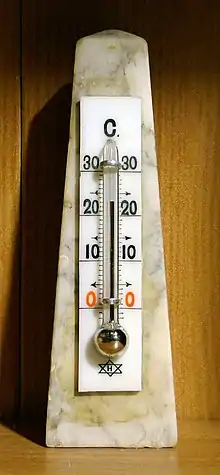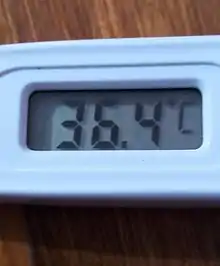Room temperature
Colloquially, "room temperature" is a range of air temperatures that most people prefer for indoor settings. It feels comfortable to a person when they are wearing typical indoor clothing. Human comfort can extend beyond this range depending on humidity, air circulation and other factors. Food or beverages may be served at room temperature, meaning neither heated nor cooled.

In certain fields, like science and engineering, and within a particular context, room temperature can mean different agreed-upon ranges. In contrast, ambient temperature is the actual temperature, as measured by a thermometer, of the air (or other medium and surroundings) in any particular place. The ambient temperature (e.g. an unheated room in winter) may be very different from an ideal room temperature.
Comfort temperatures
The American Heritage Dictionary of the English Language identifies room temperature as around 20–22 °C (68–72 °F),[1] while the Oxford English Dictionary states that it is "conventionally taken as about 20 °C (68 °F)".[2] The ideal room temperature may vary by place and culture; studies from Nigeria show a comfortable temperature range of 26–28 °C (79–82 °F), comfortably cool 24–26 °C (75–79 °F) and comfortably warm 28–30 °C (82–86 °F).[3] Owing to variations in humidity and (likely) clothing, recommendations for summer and winter may vary; a suggested typical range for summer is 23–25.5 °C (73–78 °F), with that for winter being 20–23.5 °C (68–74 °F).[4] Some studies have suggested that thermal comfort preferences of men and women may differ significantly, with women on average preferring higher ambient temperatures.[5][6][7]
In the recent past it was common for house temperatures to be kept below the comfort level; a 1978 UK study found average indoor home temperatures to be 15.8 °C (60.4 °F) while Japan in 1980 had median home temperatures of 13 °C (55 °F) to 15 °C (59 °F)[8]
Health effects

The World Health Organization in 1987 found that comfortable indoor temperatures between 18–24 °C (64–75 °F) were not associated with health risks for healthy adults with appropriate clothing, humidity, and other factors. For infants, elderly, and those with significant health problems, a minimum 20 °C (68 °F) was recommended. Temperatures lower than 16 °C (61 °F) with humidity above 65% were associated with respiratory hazards including allergies.[9][10]
The WHO's 2018 guidelines give a strong recommendation that a minimum of 18 °C (64 °F) is a "safe and well-balanced indoor temperature to protect the health of general populations during cold seasons", while a higher minimum may be necessary for vulnerable groups including children, the elderly, and people with cardiorespiratory disease and other chronic illnesses. The recommendation regarding risk of exposure to high indoor temperatures is only "conditional". Minimal-risk high temperatures range from about 21–30 °C (70–86 °F) depending on the region, with maximum acceptable temperatures between 25–32 °C (77–90 °F).[11]
Definitions in science and industry
Temperature ranges are defined as room temperature for certain products and processes in industry, science, and consumer goods. For instance, for the shipping and storage of pharmaceuticals, the United States Pharmacopeia-National Formulary (USP-NF) defines controlled room temperature as between 20 to 25 °C (68 to 77 °F), with excursions between 15 to 30 °C (59 to 86 °F) allowed, provided the mean kinetic temperature does not exceed 25 °C (77 °F).[12] The European Pharmacopoeia defines it as being simply 15 to 25 °C (59 to 77 °F), and the Japanese Pharmacopeia defines "ordinary temperature" as 15 to 25 °C (59 to 77 °F), with room temperature being 1 to 30 °C (34 to 86 °F).[13][14] Merriam-Webster gives as a medical definition a range of 15 to 25 °C (59 to 77 °F) as being suitable for human occupancy, and at which laboratory experiments are usually performed.[15]
See also
- Standard conditions for temperature and pressure
- ISO 1 – ISO standard temperature, 20°C
- Indoor air quality
References
- The American Heritage Dictionary of the English Language (5th ed.). 2014. Archived from the original on 2015-01-08.
- Oxford English Dictionary, Third Edition, November 2010), sub-entry at room.
- Komolafe, L. Kayode; Akingbade, Folorunso O. A. (2003). "Analysis of thermal comfort in Lagos, Nigeria". Global Journal of Environmental Sciences. 2: 59–65. doi:10.4314/gjes.v2i1.2407. Retrieved 4 March 2021.
{{cite journal}}: CS1 maint: url-status (link) - Burroughs, H. E.; Hansen, Shirley (2011). Managing Indoor Air Quality. Fairmont Press. pp. 149–151. ISBN 9780881736618. Archived from the original on 20 September 2014. Retrieved 25 December 2014.
- Beshir, MY; Ramsey, JD (March 1981). "Comparison between male and female subjective estimates of thermal effects and sensations". Applied Ergonomics. 12 (1): 29–33. doi:10.1016/0003-6870(81)90091-0. PMID 15676395.
- Karjalainen, Sami (April 2007). "Gender differences in thermal comfort and use of thermostats in everyday thermal environments". Building and Environment. 42 (4): 1594–1603. doi:10.1016/j.buildenv.2006.01.009.
- Kingma, Boris; van Marken Lichtenbelt, Wouter (August 2015). "Energy consumption in buildings and female thermal demand". Nature Climate Change. 5 (12): 1054–1056. Bibcode:2015NatCC...5.1054K. doi:10.1038/nclimate2741.
- Mavrogianni, A.; Johnson, F.; Ucci, M.; Marmot, A.; Wardle, J.; Oreszczyn, T.; Summerfield, A. (2021-06-02). "Historic Variations in Winter Indoor Domestic Temperatures and Potential Implications for Body Weight Gain". Indoor + Built Environment. 22 (2): 360–375. doi:10.1177/1420326X11425966. PMC 4456148. PMID 26321874.
- World Health Organization. Environmental Health in Rural and Urban Development and Housing Unit. (1990). Indoor environment : health aspects of air quality, thermal environment, light and noise (PDF). p. 17.
- Lane, Megan (2011-03-03). "BBC News Magazine: How warm is your home". BBC News. Archived from the original on 2017-12-31.
- WHO Housing and health guidelines. World Health Organization. 2018. pp. 34, 47–48. ISBN 978-92-4-155037-6.
- "General Chapter < 659> Packaging and Storage Requirements" (PDF). United States Pharmacopeia. 1 May 2017. Retrieved 2018-04-04.
- "What are the regulatory Definitions for "Ambient", "Room Temperature" and "Cold Chain"?". ECA Academy. 2 March 2017. Retrieved 2018-04-04.
- Shein-Chung Chow (2007). Statistical Design and Analysis of Stability Studies. Chapman & Hall/CRC Biostatistics Series. CRC Press. p. 7. ISBN 9781584889069. Retrieved 4 April 2018.
1.2.3.3 Definition of Room Temperature: According to the United States Pharmacopeia National Forumlary [sic] (USP-NF), the definition of room temperature is between 15 and 30 °C in the United States. However, in the EU, the room temperature is defined as being 15 to 25 °C, while in Japan, it is defined being 1 to 30 °C.
- Merriam Webster's Medical Dictionary. 2016. Archived from the original on 2010-04-10.